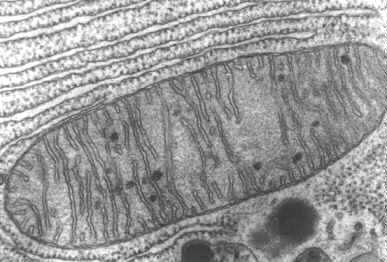

Click here to see a Human mtDNA Sequence
 permission
pending
permission
pending
Figure 1: The figure above shows an electron micrograph of a single mitochondria. http://cellbio.utmb.edu/cellbio/mitoch1.htm
Contrary to popular belief all DNA is not found in the nucleus of eukaryotic cells, some of it is found in the mitochondria. Mitochondria are the powerhouses of the cells, they produce energy for the cell in a process called respiration. They are analogous to chloroplasts, which are organelles found in plants that serve to provide energy through a process called photosynthesis. Much like chloroplasts, mithchondria are thought to be the result of endosymbiosis of bacterial organisms by higher eukaryotic organisms. Mitochondria are believed to possess ancient DNA. Because of their origins both chloroplasts and mitochondria have their own DNA, and replicated independently of the host cell. Cells in which the mitochondria have been removed will divide into daughter cells but they cannot produce their own mitochondria. In cells possessing mitochondria, the mtDNA chromosome is circular and possesses 16,000 base pairs and 34 genes, which translates into a molecule 1/300,000th the total length of nuclear DNA in human cells (Miller, 2000). The mtDNA chromosome bears great similarity to modern bacterial plasmids. Thousands of years ago mitochondria had many more base pairs and many more genes; many genes have been lost because the host cell takes care of the functions these genes were initialy used for. Unlike nuclear DNA, mtDNA has no repetitive sequences, no spacers, and no introns (Miller, 2000). It does however encode its own RNA's: mRNA, tRNA, and rRNA. Another difference between nuclear DNA and mtDNA is that mtDNA does not undergo recombination. There is no active mechanism to incorporate diversity in mtDNA so it is unchanged over thousands of generations with the exception of random mutations. Click here for a movie on the origns of mtDNA.
Figure-2 shows the electron micrographs of internalization of sperm in sea urchin eggs. (Gilbert, 2000)
Each person possess two sets of nuclear DNA: paternal and fraternal. On the other hand each person has thousands of mitochondria, each with several copies of its own DNA. Paternal mitochondria exist to power the sperm in fertilization of the egg, but are found in the flagellum of the sperm. This portion of the sperm actually falls off as soon as fertilization takes place, resulting in the loss and degradation of paternal mtDNA(Gilbert, 2000). See Figure-3 above for an example of sperm entering an egg (Gilbert, 2000) . MtDNA is most often used to study human origins and in identification and crime scene analysis. In order to utilize mtDNA in these disciplines it must first be extracted and amplified. Go to the FBI Forensic Science webpage to see how mtDNA is processed for crime investigations and missing persons cases.
Fawcett, Don Wayne. The Cell. 2d ed. Philadelphia, Penn.: W.B. Saunders Co., 1981.